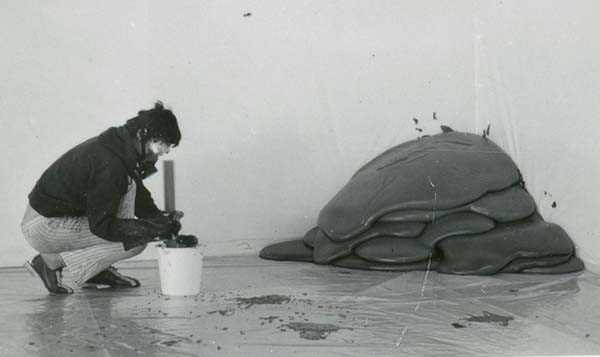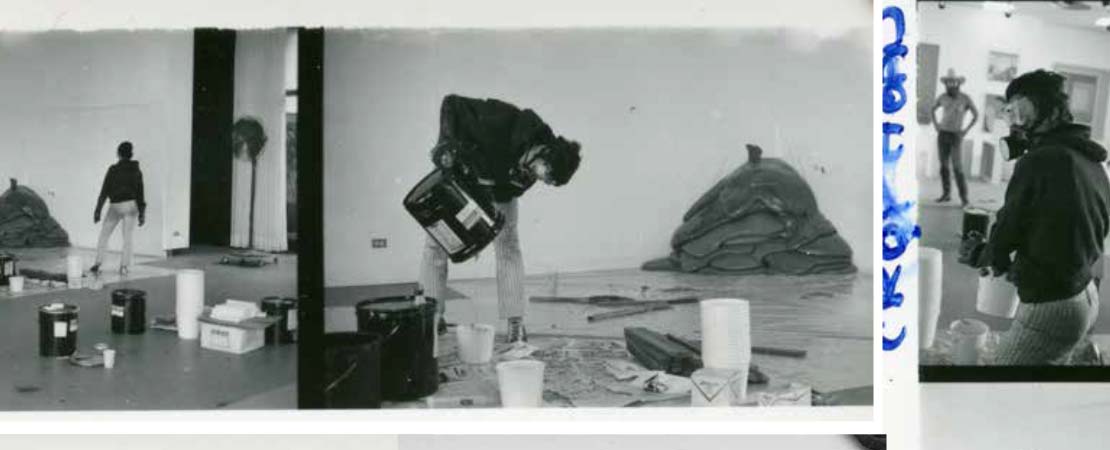In 1970, Lynda Benglis visited Dallas from her adopted home of New York City for a show of new work at the Janie C. Lee Gallery—a contemporary art gallery that focused on bringing artists from the coasts to Dallas. During Benglis’s visit, the Modern Art Museum of Fort Worth (then the Fort Worth Art Center Museum under the direction of Henry Hopkins) commissioned her to create the foam pour sculpture now in their collection. Benglis also used her time in Dallas-Fort Worth to make new work for a private collector and experiment with materials in Janie C. Lee’s backyard swimming pool. I spoke with artist Tom Orr about his recollections from that time, as a young artist working for a well-connected gallery, where he gained exposure to some of the great masters of American art, including the inimitable Lynda Benglis. His memories paint a picture of a serious and physical artist and a generous and kind person. What follows is a version of our conversation, condensed and edited for clarity and flow.
-Associate Curator Dr. Leigh Arnold
This was 52 years ago. An interesting time period. It was before I went to art school, and I had just finished two years as an art student at El Centro [Community College, now Dallas College, El Centro Campus] and was about to enroll at Rhode Island School of Design. It was a good time for me in Dallas because I had a great job. I was working for Janie C. Lee, which was a gallery in Dallas that only showed New York and California artists, and a few local artists, but not many. I was the helper. My job was to assist the artists and do whatever they needed—if they needed to be driven somewhere, I could do that. If they needed to go get something from the hardware store, I’d take them to the hardware store. I was basically in the gallery based on anything they needed to be done— “get Tom to do it.”
To Janie’s credit, she was fairly strict: “You’ve got to read this Barbara Rose book before you work with me. … You have to be cautious around this work,” and she never implied that the art was very valuable, but it was. And she said, “Whatever you do, do not”—these aren’t the exact words—“do not bother the artists.” In other words, don’t try to be a buddy. So, she had me a little bit scared of these people. But the artists—except for one, I won’t reveal the name—treated me with respect and were very nice and friendly. But I got to meet a lot of important artists and help them to some degree. It was good for me. I got to see those very early Larry Bells. Just tremendous. I had seen a lot of images in books, but I had never been around the actual artworks.
Then Lynda, of course. She was established already—she’d had several shows in New York, and I don’t know if she had anything in museums, but she was doing really well for herself at that time. She was not a superstar, but she was certainly up there with a lot of contemporary artists. So, I knew her works slightly from being around Janie, and, of course, Artforum and other publications. I think she might even have been in Life magazine or something at some point. I forget now. But she was on the way up, and I had only seen some pictures of the poured pieces, the ones on the ground. Flat ones. I think Janie had shown me a picture of one of the corner pieces or wall pieces that was kind of stacked up against the wall, but the things that I first saw in person were these—I think they call them lozenge shapes. They were 2 x 4s with a rounded top and a bottom, and then they were dipped in wax.1 They were just beautiful, just fantastic things. Pretty darn fragile, too. And I can remember looking and thinking: “Oh my God! If it gets too hot they’re gonna melt.” When I talked to Lynda later, she said, “Well yeah, they can and they are fragile, but fragile on the surface.” But she investigated waxes and various materials and came up with something that was pretty darn durable for the wax.

When I was working with Lynda it was the spring and the early part of the summer of 1970, I had to leave in late June to go to a summer session at RISD. I think she was here for at least a couple of weeks, maybe a little bit longer because she had come to Dallas to make some pieces for a show at Janie’s along with the Modern Art Museum of Fort Worth, in its old location.
Lynda wasn't really fond of having a crowd watch her. When I helped her in Fort Worth with that corner piece, she made it outside, and maybe some people from the museum were kind of watching in the background. I think I remember her, saying “I just don't want people hanging around. I'm not doing a performance; I am working on a piece.”
That was a cool thing about her: She was so intent when she worked. All I could do was watch. You can imagine how that process works with those corner pieces that you are adding to, and you can't really take much away from. You’ve got to be pretty precise and, of course, it is foam too, so you pour and it gets bigger. It was amazing to watch, I am telling you.
I was an art student and just beginning to work myself then, but what was very obvious was that Lynda was in control. She knew exactly what she was doing, even though there would be some happy accidents, she was in control, and she had total concentration. She was in very good shape and really strong. I was impressed at the concentration, and it was pretty much an all-day thing. I mean, she would break for lunch, and stop and rest every now and then, but she really gave it a lot in terms of total concentration, and that was impressive to me because I didn't really know how to work [like that]. I work that way now, but at the time I thought, "Man. ..." It was just great. She didn't make it look easy, but she made it look like something that wasn't like a magic trick. The sculpture is incredible, but it came from doing really hard work and really concentrating, like, there's no secret to this thing, but that's the method that she used to get work done. Exciting work. I saw that you gotta concentrate, you have to work hard and that's what she did. And it was a valuable lesson to witness.

When she was doing these pieces, my job was to remain quiet and just watch her and see if she needed anything because a lot of times, she would have to get another bucket of foam and quickly mix it. I had to be ready. I didn't mix any of it; she mixed it, but I would hand her things and when she was done and she finished the pour, I’d grab the bucket and take it out of the way.
I saved those buckets for long time. I had 10 or so from the Fort Worth pour piece. When I went to RISD, I gave my old car back to my folks and left those buckets in the car. My mother said, “We need to save these buckets because she is gonna be famous one day.” So, she kept them for years up in the attic, but they're long gone now.
Because my big ’52 Dodge didn’t have air conditioning and it was getting warm, Lynda and I had to drive over to Ft. Worth to the museum early in the mornings. During the drive, Lynda was pretty quiet, but she would talk to me about things she knew and thought I might be interested in. She talked a lot about materials. She would ask me what I was doing and about going to art school. It was just a nice drive in the morning. She treated me like an adult and like a fellow artist even though I really wasn't yet.
Lynda Benglis will be on view at the Nasher Sculpture Center from May 21 to September 18, 2022.
Lynda Benglis (b. 1941). For Carl Andre, 1970. Pigmented polyurethane foam, 56 1/4 x 53 1/2 x 46 3/16 in. (142.88 x 135.89 x 117.32 cm). Archival images of Lynda Benglis commission. Courtesy of the Modern Art Museum of Fort Worth.
1 For Benglis's wax paintings, layers of a mixture of purified pigmented beeswax and damar resin were brushed onto lozenge-shaped Masonite panels of approximately 36 x 5 in.